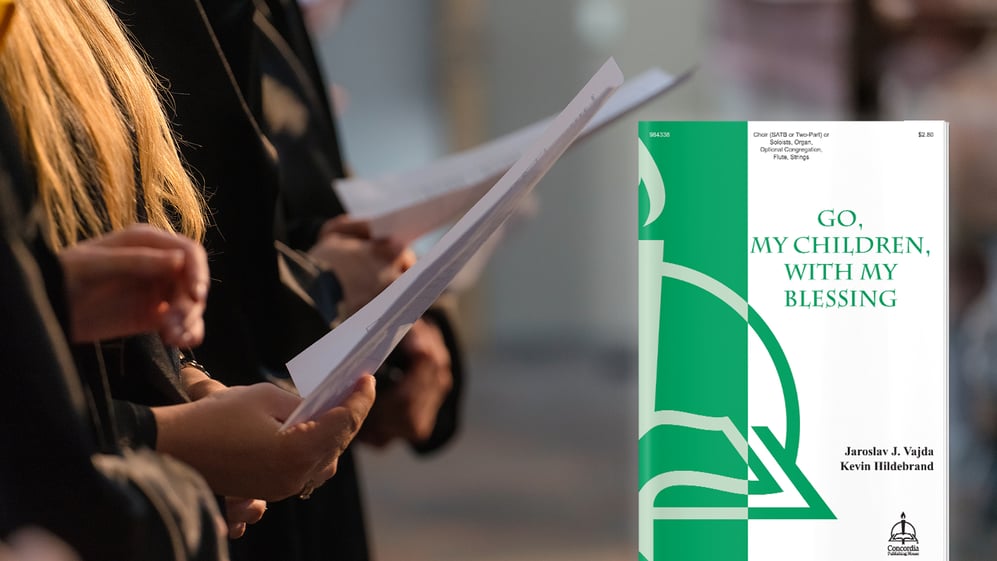Composed in commemoration of the centennial of the birth of Jaroslav J. Vajda (1919–2008), Kevin Hildebrand’s setting of the favorite hymn is flexible for SATB or two-part choir or soloists, organ, optional congregation, flute, and strings. The introduction may be played as an independent piece of service music or adapted if a shorter introduction is desired. The choral score includes the SATB or two-part choir, organ, flute, and reproducible congregational pages—one for general use and the other with an optional stanza for weddings. The full score includes parts for string quartet.
The Text
Go, My children, with My blessing,
Never alone.
Waking, sleeping, I am with you;
You are My own.
In My love's baptismal river
I have made you Mine forever.
Go, My children, with My blessing—
You are My own.
Go, My children, sins forgiven,
At peace and pure.
Here you learned how much I love you,
What I can cure.
Here you heard My dear Son's story;
Here you touched Him, saw His glory.
Go, My children, sins forgiven,
At peace and pure.
In this union I have joined you
Husband and wife,
Now, My children, live together
As heirs of life:
Each the other's gladness sharing,
Each the other's burdens bearing,
Now, my children, live together
As heirs of life.
Go, My children, fed and nourished,
Closer to Me;
Grow in love and love by serving,
Joyful and free.
Here My Spirit's power filled you;
Here His tender comfort stilled you.
Go, My children, fed and nourished,
Joyful and free.
I the Lord will bless and keep you
And give you peace;
I the Lord will smile upon you
And give you peace:
I the Lord will be your Father,
Savior, Comforter, and Brother.
Go, My children; I will keep you
And give you peace.
The scope of the hymn mirrors that of the Divine Service, beginning with Baptism, and continuing through Absolution, Communion, and Benediction, as Hildebrand describes:
Stanza 1 traces the creation of the Christian's new life in Baptism. Stanzas 2–4 outline how the Christian is "fed and nourished" in the Divine Service week after week, year after year. Stanza 2 describes the forgiveness we hear about in Holy Absolution and how we learn of God's love in the proclamation of the Word. Stanza 3 never uses the words "Holy Communion," but it's there in the description of being fed and nourished, and how God draws us close to Himself in the Lord's Supper. The Post-Communion Collect is referenced in how we "grow in love and love by serving," reminiscent of the "fervent love toward one another" we hear in the collect. Finally, stanza 4 is a paraphrase of the Benediction at the conclusion of the Divine Service, and ties the hymn title together so nicely. It's my hope that as people use and sing this hymn setting that those images of God's tender mercy and gifts given in the Divine Service are underscored for the singers.
Writing a hymn setting allows composers to meditate on a text throughout the composition process, which is something that allowed Hildebrand to explore the richness of Vajda's beloved text:
One of the benefits a composer has in working on a hymn setting is being able to live with a hymn text for the time it takes to create the composition. You get to spend so much more time with those words, phrases, rhymes, and scriptural allusions than anyone else does when they are simply singing the hymn and making the music happen. Sometimes people look at the title of this hymn and assume (wrongly) that this hymn is about moms and dads singing about and to their children. But you soon realize that the text really is the triune God in the first person describing the love He has for His baptized children (the capitalized pronouns such as My and Mine help us keep track of God's actions toward us). The hymn is really about our Christian life that God creates and sustains.
Hildebrand's setting includes Vajda's alternate stanza for weddings, which may be used in place of stanzas 2 and 3. This stanza invokes God as heavenly Father who bids His children (in this case, a husband and wife) to live together as heirs of life.
The Setting
This setting provides the user with multiple performance options, depending on occasion and availability. Hildebrand describes the benefit of producing a setting that may be used in a variety of ways:
The more specific requirements a composer places on a piece, that becomes an increasingly limited factor for practical purposes. For instance, I had a desire to score this piece for strings, since I had done an earlier arrangement of this tune for a hymn festival several years ago, and included a chamber orchestra. This lovely Welsh tune just becomes lovelier with the warm sound of a string ensemble. However, I know full well that hardly any churches are going to have a string ensemble on hand! I'd rather find a way to adapt a piece with or without specific instruments so that the music can be shared and performed more easily. Besides, even if a composer would indicate "string ensemble obbligato" in the score, those directives are often ignored anyhow. Perhaps a special service or a wedding would suggest hiring or organizing a string ensemble, and then the string parts could be used for that performance.
While the church musician is free to make decisions about instrumental accompaniment and performance, the choral stanzas may be sung using either SATB or two-part choir, or soloists. Again, this accommodates vocal ensembles of all sizes.
The introduction to the hymn may be played as a standalone performance, or it may be used to introduce the hymn as a processional or at a wedding. The first twelve measures of the introduction may serve as an introduction to the hymn itself, if a shorter introduction is desired.
Between the flexible scoring, the alternate wedding stanza, the options for choral harmonies, and more, Hildebrand's setting of Vajda's well-known hymn provides the church musician with an array of performance options.
When the hymn is sung, this rich setting will remind the Christian of God's love and gifts He pours into His Church in the Divine Service.
Purchase Kevin Hildebrand's setting of "Go, My Children, with My Blessing."













.jpg?width=50&height=50&name=IMG_20220621_160541_456%20(1).jpg)